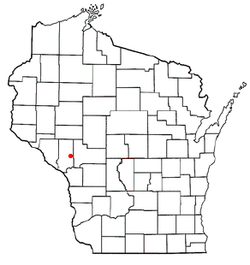Blair, Wisconsin
| Blair, Wisconsin | |
|---|---|
| City | |

Downtown Blair on WIS 95
|
|
 Location of Blair, Wisconsin |
|
| Coordinates: 44°17′42″N 91°13′48″W / 44.29500°N 91.23000°WCoordinates: 44°17′42″N 91°13′48″W / 44.29500°N 91.23000°W | |
| Country | United States |
| State | Wisconsin |
| County | Trempealeau |
| Area | |
| • Total | 1.24 sq mi (3.21 km2) |
| • Land | 1.15 sq mi (2.98 km2) |
| • Water | 0.09 sq mi (0.23 km2) |
| Elevation | 853 ft (260 m) |
| Population (2010) | |
| • Total | 1,366 |
| • Estimate (2012) | 1,367 |
| • Density | 1,187.8/sq mi (458.6/km2) |
| Time zone | Central (CST) (UTC-6) |
| • Summer (DST) | CDT (UTC-5) |
| Area code(s) | 608 |
| FIPS code | 55-08075 |
| GNIS feature ID | 1561910 |
| Website | cityofblair |
Blair is a city in Trempealeau County, Wisconsin, along the Trempealeau River. The population was 1,366 at the 2010 census.
Blair is on the former Green Bay and Western Railroad, which ran down the Trempealeau River valley to Winona, Minnesota.
The city was first settled during the 1850s. The majority of the city's population are descended from Norwegian settlers, with a smaller group descended from German settlers. The city's Norwegian heritage is represented by annual lefse and lutefisk suppers at the churches and a love of polka music. A lefse company is located in Blair.
The city's name was changed from Porterville in 1873 when the Green Bay and Western Railroad was routed through the city. The new name of Blair came from one of the railroad's chief investors, John Insley Blair. At one time, during the heyday of railroads, a branch line connected the GB&W with the nearby city of Ettrick (although it was later abandoned). The railroad continues to operate, although under a different name.
The city has avoided the fate of some small towns in the Midwest which slowly lost population due to young people leaving for jobs elsewhere. The population of Blair nearly doubled in the years between 1950 and 2000. During the 1950s and earlier annual floods during the snow melt were often experienced, but better farming techniques now make flooding rare. More recently, a number of Amish farming families have settled in the area and their horse-drawn carriages are sometimes seen on the roads.
...
Wikipedia
